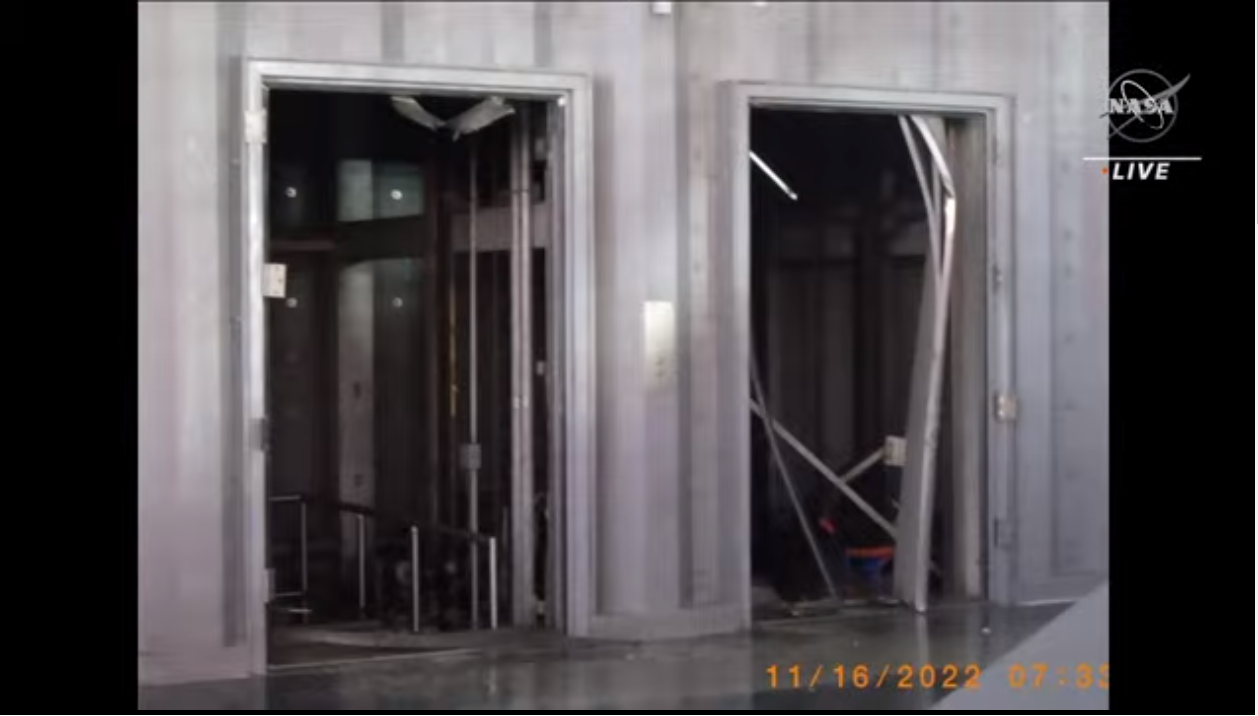Huge Artemis 1 moon rocket blew the doors off NASA's launch tower elevators (video)
'The environment ... is not the friendliest when when you have the world's most powerful rocket lifting off.'
NASA's powerful new moon rocket damaged its launch pad and blew away elevator doors in the launch tower during its inaugural liftoff last week.
Artemis 1, the first flight of the Artemis program, launched early Wednesday morning (Nov. 16). Nearly 9 million pounds (4 million kg) of thrust took the Space Launch System (SLS) rocket into the final frontier, where it successfully sent an uncrewed Orion spacecraft toward the moon.
While the mission is otherwise nominal, the damage left behind is something NASA is closely looking at to prepare for future missions of the Artemis program, including the next planned one with humans on board: Artemis 2, set to fly around the moon no earlier than 2024.
"The damage that we did see pertains to really, just a couple of areas," emphasized NASA's Mike Sarafin, Artemis mission manager, in a press conference with reporters on Monday (Nov. 21).
"It just goes to show," he added, "that the environment ... is not the friendliest when you have the world's most powerful rocket lifting off."
In photos: Amazing views of NASA's Artemis 1 moon rocket debut
Like the space shuttle before it, Artemis 1's launch used a water suppression system to reduce the amount of damage to the launching deck, which worked as expected. Nevertheless, paint was peeled off the deck of Artemis 1's launch tower due to the sheer force of the liftoff, Sarafin said.
Get the Space.com Newsletter
Breaking space news, the latest updates on rocket launches, skywatching events and more!
The elevators for servicing the launch tower fared less well, with photos showing crooked framing around at least one of the two lifts after the doors were ripped away by the shock wave generated by the SLS.
"The elevator system is not functioning right now," Sarafin explained. "The pressure basically blew the doors off our elevators ... right now, the elevators are inoperable, and we need to get those back into service."

Minor damage was induced to the pneumatic lines associated with gaseous nitrogen and gaseous helium to service the massive SLS tanks, which tricked oxygen sensors on the pad into reading low oxygen levels amid the leaking gas, NASA officials added.
Managers also found two small flight items near the pad that shouldn't have been there: "throat plug material" expelled from the rocket during liftoff (which happens from time to time with rocket launches), and one piece of RTV (insulating caulking) from the base of the Orion capsule.
It is unclear, however, whether the RTV flew off during launch or came off during Tropical Storm Nicole, which ripped off a strip of caulking prior to the launch; mission managers had determined before launch that the RTV issue would not be a risk.
The damage was minor enough that Sarafin characterized SLS as "a very clean system," adding that the rocket exceeded its performance targets and that the team will make some changes for Artemis 2.
"This is about being as safe as we can, given the hostile environment that we're flying into for our astronauts," he said of the mission planning at large, including the launch phase. "We take this very seriously. Flight safety for our astronauts is paramount."
Elizabeth Howell is the co-author of "Why Am I Taller?" (ECW Press, 2022; with Canadian astronaut Dave Williams), a book about space medicine. Follow her on Twitter @howellspace. Follow us on Twitter @Spacedotcom or Facebook.
Join our Space Forums to keep talking space on the latest missions, night sky and more! And if you have a news tip, correction or comment, let us know at: community@space.com.

Elizabeth Howell (she/her), Ph.D., was a staff writer in the spaceflight channel between 2022 and 2024 specializing in Canadian space news. She was contributing writer for Space.com for 10 years from 2012 to 2024. Elizabeth's reporting includes multiple exclusives with the White House, leading world coverage about a lost-and-found space tomato on the International Space Station, witnessing five human spaceflight launches on two continents, flying parabolic, working inside a spacesuit, and participating in a simulated Mars mission. Her latest book, "Why Am I Taller?" (ECW Press, 2022) is co-written with astronaut Dave Williams.









